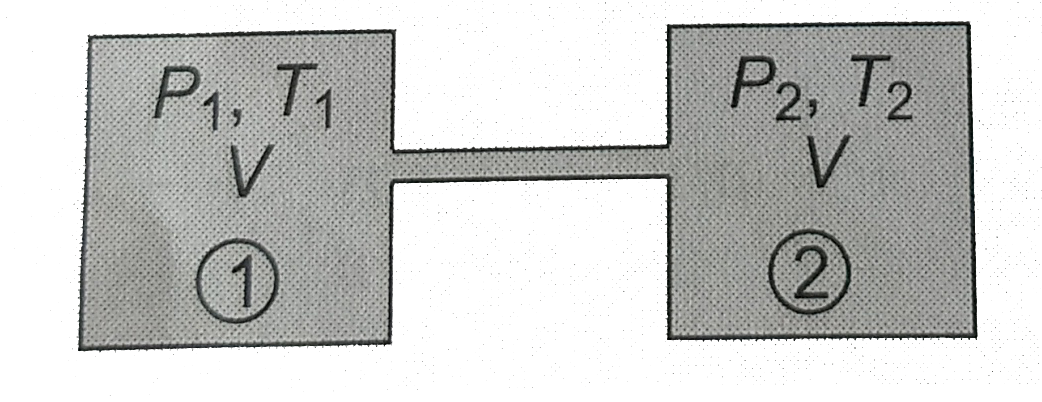Two vessels of volume (V1)and(V2) contain the same ideal gas. The pressures in the vessels are (P1)and(P2) and the temperatures are (T1)and(T2) respectively . The two vessels are now connected to each other through a narrow tube. Assuming that no heat is exchanged between the surrounding and the vessels, find the common pressure and temperature attained after the connection.
On opening the valve, the air will flow from the vessel at heigher pressure to the vessel at lower pressure till both vessels have the same air pressure. If this air pressure is p, the total volume of the air in the two vessels will br (V1+V2). Also if v1 and v2 be the number of moles of air initially in the two vessel, we have
p1V1=v1RT1 and p2V2=v2RT2 ....(1)
After the air is mixed up, the total number of moles are (v1+v2) and the mixture is at temperature T
Hence p(V1+V2)=(v1+v2)RT ....(2)
Let us look at the two portions of air as one single system. Since this system is contained in a thermally insulated vessel, no heat excharge is involved in the process. That is, total heat transfer for the combined system Q=0
Moreover, this combined system does not perform mechanical work either. The walls of the containers are rigid and there are no pistons etc to be pushed, looking at the total system, we know A=0
Hence, internal energy of the combined system does not change in the process. Initially energy of the combined system if equal to the sum of internal energies of the two portions of air :
Ul=U1+U2=v1RTγ−1+v2RT2γ−1 ...(3)
Final internal energy of (n1+n2) moles of air at temperature T is given by
Uf=(v1+v2)RTγ−1 ....(4)
Therefore, Ul=Uf implies :
T=v1T1+v2T2v1+v2=p1V1+p2V2(p1V1/T1)+(p2V2/T2)=T1T2p1V1+p2V2p1V1T2+p2V2T2
From (2). therefore, final pressure is given by :
p=v1+v2V1+V2RT=RV1+V2(v1T1+v2T2)=p1V1+p2V2V1+V2
This process in an example of free adiabatic expansion of ideal gas.
Topper's Solved these Questions
- BOOK - IE IRODOV, LA SENA & SS KROTOVCHAPTER - THERMODYNAMICS AND MOLECULAR PHYSICSEXERCISE - Kinetic Theory Of Gases51videos
THERMODYNAMICS AND MOLECULAR PHYSICS
- BOOK - IE IRODOV, LA SENA & SS KROTOVCHAPTER - THERMODYNAMICS AND MOLECULAR PHYSICSEXERCISE - The Second Law Of Thermodynamics - Entropy47videos
THERMODYNAMICS AND MOLECULAR PHYSICS
- BOOK - IE IRODOV, LA SENA & SS KROTOVCHAPTER - THERMODYNAMICS AND MOLECULAR PHYSICSEXERCISE - Transport Phenomena38videos
THERMODYNAMICS AND MOLECULAR PHYSICS
- BOOK - IE IRODOV, LA SENA & SS KROTOVCHAPTER - PHYSICAL FUNDAMENTALS OF MECHANICSEXERCISE - Relativistic Mechanics49videos
PHYSICAL FUNDAMENTALS OF MECHANICS
Similar Questions
Two vessels A and B with rigid walls containing ideal gases. The pressure, temperature and the volume are P1,T1,V in the vessel A and P2,T2,V in the vessel B. The vessels are now connected through a small tube. In equilibrium, pressure P and temerature T becomes same in two vessels. Find the value of P/T.
 View Solution
View SolutionTwo chemically non-reactive gases are separately contained in two vessels of same capacity at pressure P1, and P2, respectively. If two vessels are connected, the total pressure of gaseous mixture will be
View Solution
Knowledge Check
- Question 1 - Select One or More
Two vessels of the same volume contain the same gas at same temperature. If the pressure in the vessels is in the ratio of 1 : 2, then
Athe ratio of the average kinetic energy is 1 : 2Bthe ratio of the root mean square velocity is 1 : 1Cthe ratio of the average velocity is 1 : 2Dthe ratio of number of molecules is 1 : 2 - Question 2 - Select One
Two containers of equal volume contain the same gas at pressure P1 and P2 and absolute temperature T1 and T2, respectively. On joining the vessels, the gas reaches a common pressure P and common temperature T. The ratio P/T is equal to
AP1T1+P2T2BP1T1+P2T2(T1+T2)2CP1T2+P2T2(T1+T1)2DP12T1+P22T2 - Question 3 - Select One
Two containers of equal volume contain the same gas at pressure P1 and P2 and absolute temperature T1 and T2, respectively. On joining the vessels, the gas reaches a common pressure P and common temperature T. The ratio P/T is equal to
Ap1T2+p2T1T1×T2Bp1T2+p2T1T1+T2C12[p1T2+p2T1T1T2]Dp1T2−p2T1T1×T2]
Two identical vessels contain the same gas at pressure P1 and P2 at absolute temperature T1andT2, respectively. On joining the vessels with a small tube as shown in the figure. The gas reaches a common temperature T and a common pressure P. Determine the ratio P/T
 View Solution
View SolutionTwo flasks R and S of volume V1andV2 contain same gas at pressure P1andP2 respectively at the same temperature. Pressure of the gas when the flasks R and S are connected by a tube of negligible volume is
View SolutionTwo closed vessels of equal volume containing air at pressure P1 and temperature T1 are connected to each other through a narrow tube. If the temperature in one of the vessels is now maintained at T1 and that in the other at T2, what will be the pressure in the vessels?
View SolutionTwo vessels A and B have volumes V and 4V respectively Both vessels contain some water The pressure in the space above water is P1 in vessel A and P2 in vessel B at temperature T which one is correct ? .
View SolutionTwo closed vessels of equal volume containing air at pressure P1 and temperature T1 are connected to each other through a narrow tube. If the temperature in one of the vessels is now maintained at T1 and that in the other at T2, what will be the pressure in the vessels?
View Solution

